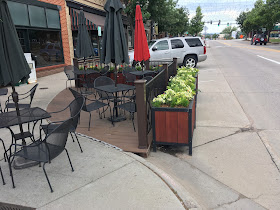 |
| Cities are leasing parking spots to restaurants for rental fees |
by Greg Saville
Years ago I spent an afternoon with the exceptional urban designer Richard Gardiner. Anyone reading encyclopedia references about the beginning of CPTED will recognize Richard Gardiner’s name, especially his 1978 book Design for Safe Neighborhoods, the first attempt to transform CPTED into a comprehensive planning system.
In our chats, Richard described how he had moved away from CPTED and began focusing on the serious congestion problem of street parking. He had developed an ingenious parking management program to tackle the assumption that “free parking is actually costing governments and institutions millions of dollars each year without their actually being aware of it. Public parking in cities constitutes the third-highest hidden cost that U.S. cities face each year.”
 |
| A "waiting area" where patrons stand in line for food and entertainment inside the bar |
PARKING SPACES FOR LEASE
Lately, I’ve seen a fascinating variation on this theme: Municipalities that lease the street parking areas in front of restaurants and bars. The bars turn this area into outside sitting areas, eating areas or other uses for their patrons.
 |
| Landscaping to beautify former parking spots - Is this a proper use of public land? |
Obviously, funds from leased parking spaces will feed city coffers and that might help recover the hidden costs of free parking (costs barely recovered by meter parking). Those funds might help cash starved municipalities reinvest into their cities.
But what, I wonder, does this rented use of public space mean for other types of transportation, such as bicycle riders who still have inadequate and safe parking spots for their bikes? Most cities still refuse to provide space for homeless tiny home villages. What about them?


